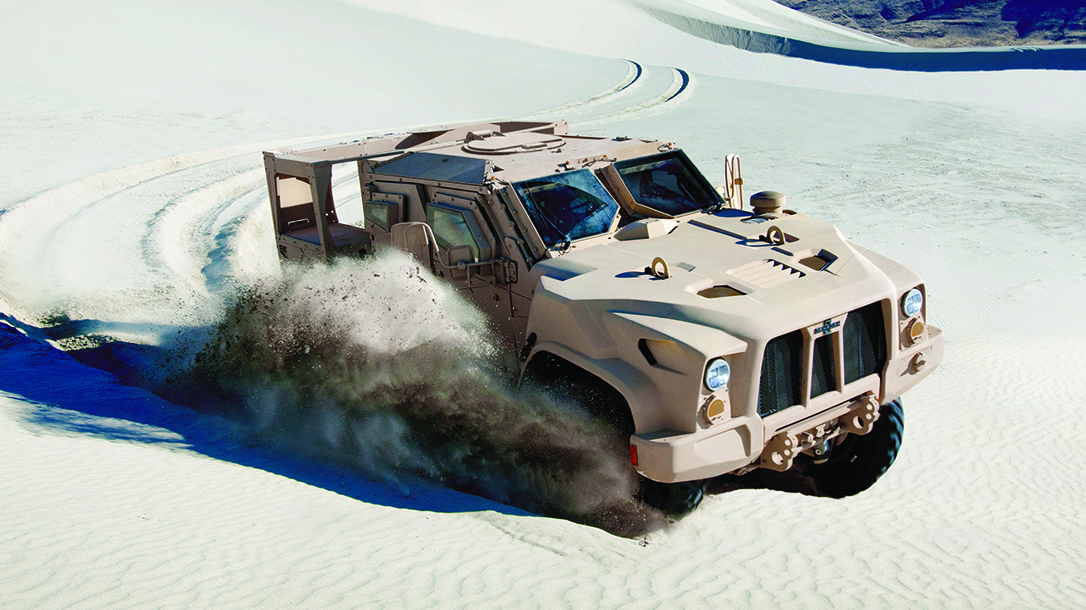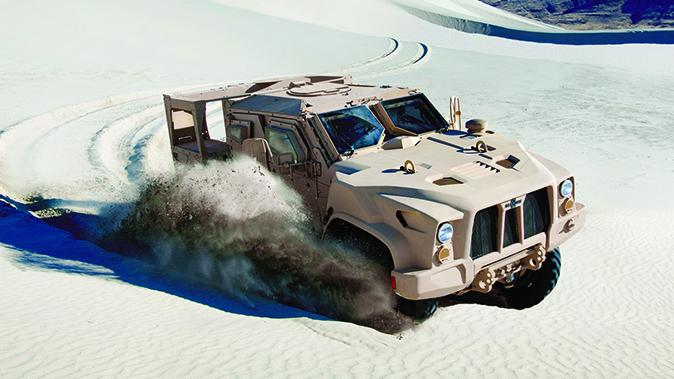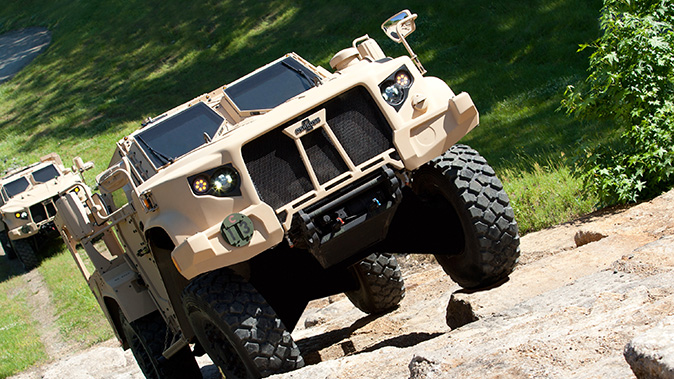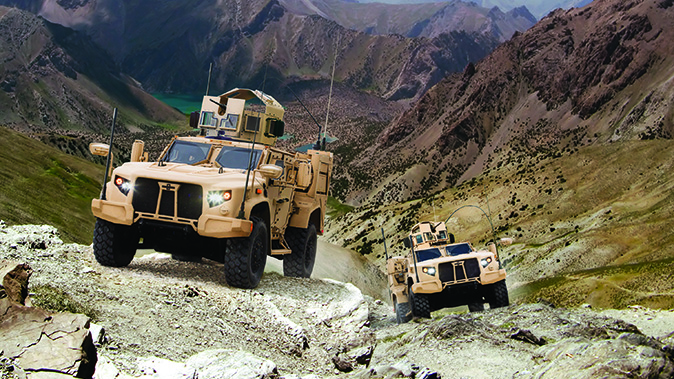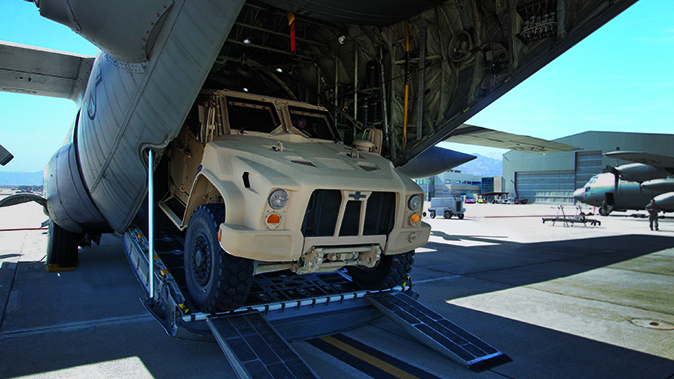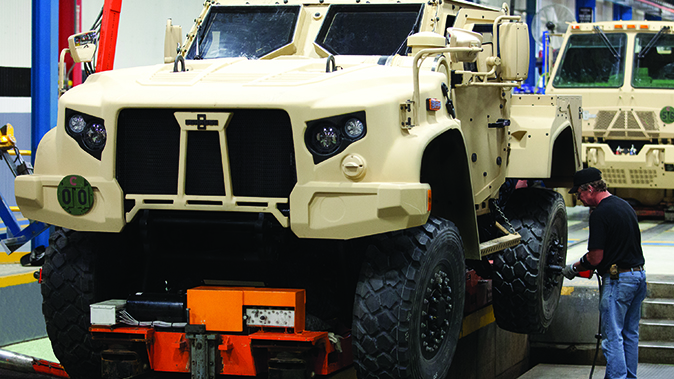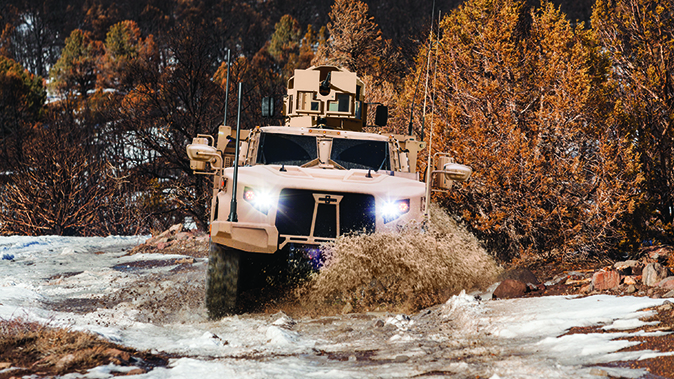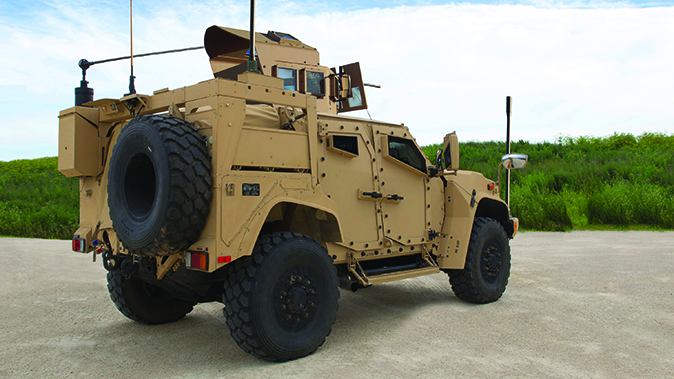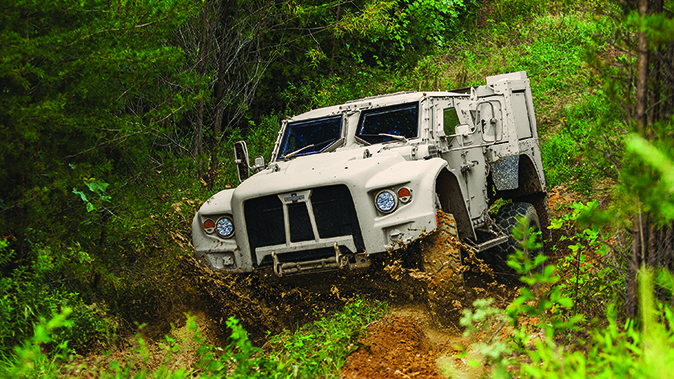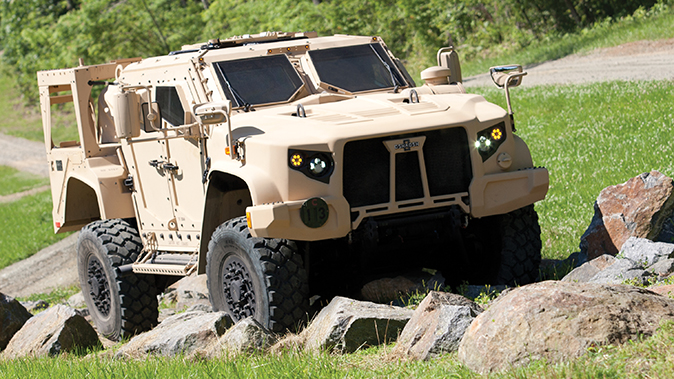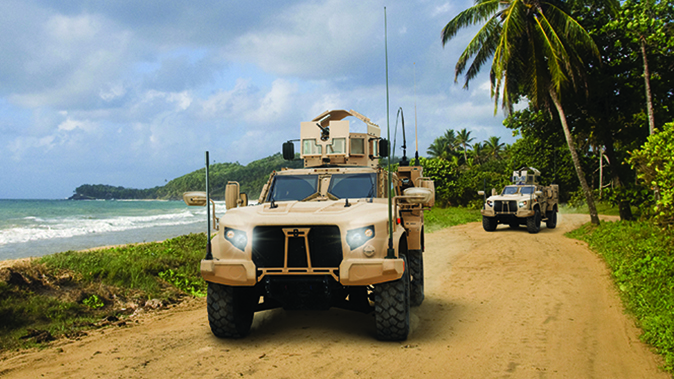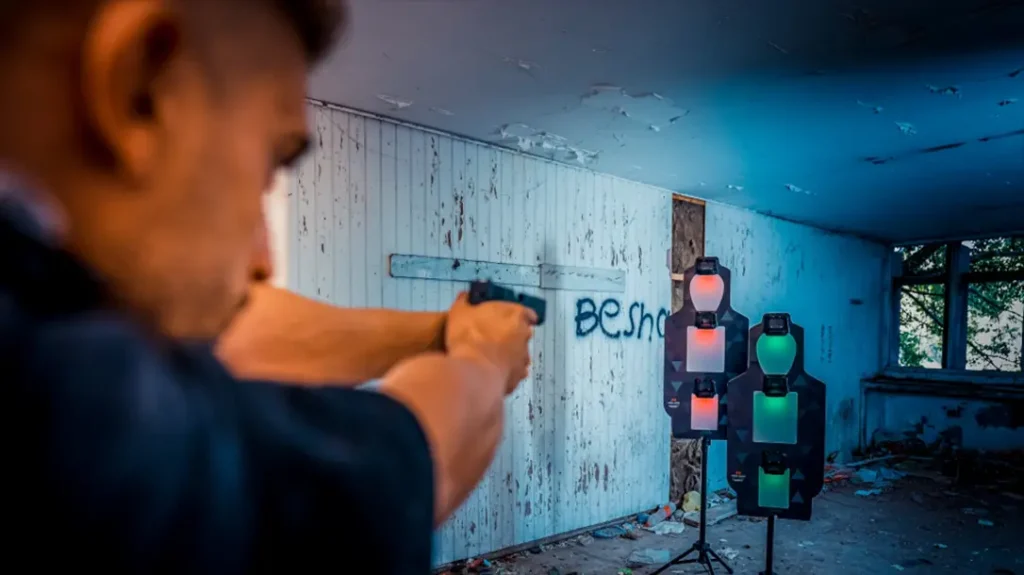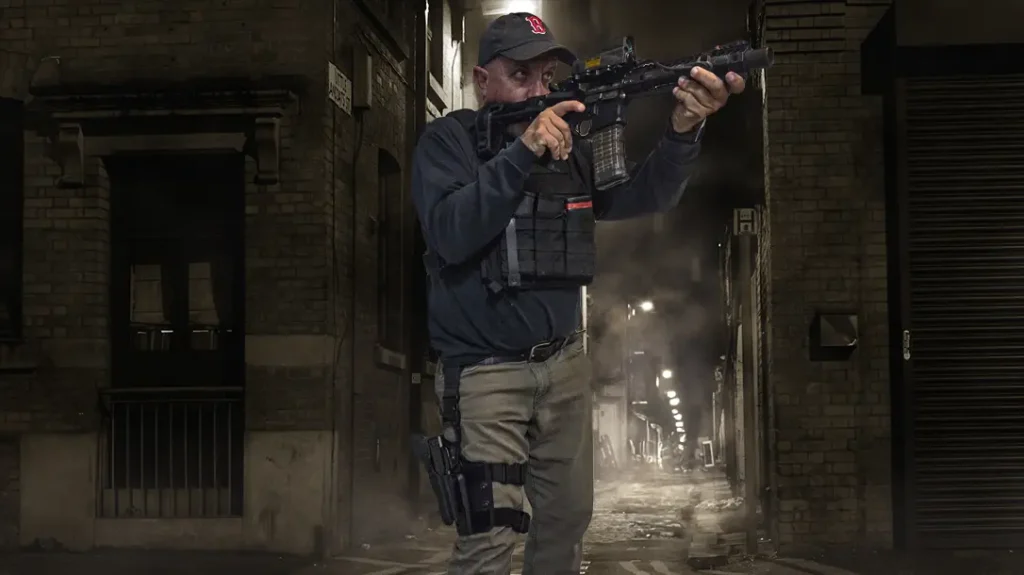Surprisingly few light vehicle designs have served the U.S. armed forces since World War II. The classic military Jeep set the standard not just in the U.S. but globally, starting with its introduction in 1941. Jeeps or close derivatives served continuously around the world for more than 40 years. They eventually relinquished their military utility transport role in the mid-1980s to the High-Mobility Multipurpose Wheeled Vehicle (HMMWV, better known as the Humvee), currently the standard U.S. light utility vehicle.
Although it hasn’t generated the Jeep’s universal affection and regard, the Humvee’s career has been as illustrious as its predecessor. It has seen ubiquitous service in an extremely wide variety of roles and missions. After more than 30 years of service, however, the Humvee’s days are numbered.
Advertisement — Continue Reading Below
The reason is the changing nature of warfare. The Humvee is rugged, with excellent off-road capabilities for force mobility. However it was never intended to provide ballistic protection for crews, passengers or cargo on the front lines. In addition, in unconventional warfare and counter-insurgency operations, there are no front lines. The demarcation between front and rear echelons has essentially disappeared. As a result, Humvees and the troops inside them are vulnerable to attacks and ambushes anywhere, anytime.
Improvised explosive devices (IEDs) have been especially troublesome for vehicles without armor protection, but Humvees have borne the brunt of these assaults because there are so many of them employed in convoy duty and other transport missions. In fact, since the advent of operations in Afghanistan and Iraq, IED attacks are responsible for more than 60 percent of American casualties—that’s more than 3,000 dead and 33,000 wounded—many of whom were in unprotected Humvees.
These woeful totals demonstrate not only the inadequacy of light military vehicles in combat, but also the unpreparedness of American forces when confronted with IED threats. Troops resorted to expedient measures that seem almost pathetic in retrospect—wrapping thin-skinned Humvees with plywood and chicken wire, for example. After a significant delay, the Department of Defense (DoD) responded with the Mine- Resistant Ambush Protected (MRAP) vehicle. The MRAP’s heavy armor can withstand IED attacks. But the vehicle’s heft sacrifices speed, mobility and maneuverability. In addition, their acquisition and operational costs are high.
Advertisement — Continue Reading Below
New Requirements
The need for something new and different was obvious and urgent. Both the Army and Marine Corps called for a new tactical vehicle design to replace the Humvee, providing the right mix of armor protection and high mobility for counter- insurgency warfare. As a result, in January of 2006, the DoD launched a new Joint Light Tactical Vehicle (JLTV) program to develop a Humvee successor with protected mobility. The DoD issued requests for information (ROIs) for potential producers.
The new program faced several challenges, including joint service requirements and avoidance of obsolescence during development as other vehicles, including lightweight MRAPs, evolved. By the end of 2006, however, the DoD approved a Concept Refinement phase for the program, followed by a Technical Development phase in early 2008 involving requests for proposals (RFPs) for competitors. Seven companies and consortiums submitted proposals. The government selected three competitors in October of 2008. These competitors included Lockheed Martin, General Tactical Vehicles and BAE Systems/Navistar.
Selection
Selection of these competitors did not, however, prevent others from competing in the subsequent Engineering and Manufacturing Development (EMD) contract phase. That phase was delayed until late 2011 as the DoD refined and changed program requirements. Seven competitors—including Oshkosh Defense, which had been eliminated in the initial program phase—offered EMD design proposals. Oshkosh’s concept, the Light Combat All-Terrain Vehicle (L-ATV), was derived from an earlier design created with Northrop Grumman. The design didn’t make the initial cut.
Advertisement — Continue Reading Below
Of interest, Oshkosh has specialized in large, heavy transport vehicles for the U.S. armed forces and also developed successful MRAPs, giving it significant experience in armored vehicles. Furthermore, in August of 2013, Oshkosh and two other contractors, Lockheed Martin and AM General, each delivered 22 vehicles for about a year’s worth of testing and evaluation in a variety of locations with different climates and terrain. As a result, after submission of final proposals in February of 2015, the government announced in August that Oshkosh Defense won the competition.
Oshkosh’s Take
John Bryant, Oshkosh Defense’s senior vice president of defense programs, explained the company’s strategy. “Oshkosh invested significantly in independent research and development (IR&D) to make sure that we could focus of the government’s JLTV Engineering and Manufacturing Development contract and offer a more advanced and mature platform than our competitors,” he said during a recent interview. The company focused on perfecting its design to meet or exceed the DoD’s full range of structural and operational requirements.
“Oshkosh’s JLTV involvement extended over about 10 years, counting our early technical development work with our partner in the program’s first phase.” Bryant added. “We weren’t chosen, but that gave Oshkosh an opportunity to work in parallel with the government’s development efforts. Our IR&D investment enabled us to evolve the L-ATV over six generations, and we could accomplish this over a more commercial timeline. We actually moved through developmental phases more quickly than the government’s technical development program. So when the government initiated the JLTV EMD, Oshkosh was already in position with a very mature platform offering incredible protection, the highest off-road mobility levels and a fully integrated modular C4ISR suite.”
Advertisement — Continue Reading Below
Winning Formula
The outcome of this effort successfully addressed the program’s next-generation vehicle requirements. “The Oshkosh JLTV offering provides protection previously seen only in light tanks, the mine resistance of an MRAP, and the speed and maneuverability of a Baha racer, with C4ISR capabilities of a mobile command post, something never done before,” Bryant added.
“In the most basic terms, Oshkosh offered more protected mobility at a better price than our competitors,” he explained. “The competition was intense. We also provided the best value for procurement and operational costs. The selection process was innovative, including not only technical criteria but also delivery capabilities over the program’s life. Fuel economy was very significant, and our vehicle delivers better than 10 payload ton-miles per gallon,” said Bryant, a retired Marine Corps colonel who served in tanks and later managed Marine Corps armored vehicle programs.
The DoD could not formalize Oshkosh Defense’s winning proposal for more than six months because one competitor protested the decision, an increasingly common byproduct of fewer large defense procurement programs, and then filed a lawsuit, later dropped, to stop initial production after losing the competition. One reason for dropping the lawsuit may have been the release of test data showing the L-ATV’s reliability metric (mean miles between operational mission failure, or MMBOMF) was 5.5 to 13.4 times better than the two other finalists.
Advertisement — Continue Reading Below
Moving Forward
Today, Oshkosh is prepared to move forward at full steam with L-ATV production. The program therefore involves exceptionally large production numbers and will continue for decades. According to recent reports, the Low Rate Initial Production (LRIP) contract is worth $114 million over two years. Furthermore, a five-year Full-Rate Production (FRP) contract, worth up to $6.75 billion, is due in 2018. The total program value is more than $24 billion, factoring in anticipated program economies.
Initial Operating Capability (IOC) for both services, when the first operational units are fully equipped, is slated for 2020. The Army requires more than 49,000 vehicles, and the Marines call for 5,500. These totals do not include planned derivatives or international sales. Production will continue at least 25 years, through 2040. There are currently two JLTV variants, and three payload categories are planned. Furthermore, JLTVs may be externally sling-loaded under Army CH-47 Chinooks or Marine CH-53 Sea Stallion helicopters. They can also be carried in C-130 transport aircraft.
Details
So what is the JLTV all about? The Oshkosh design combines unprecedented protection and mobility. “This has never before been achieved,” Bryant said, adding, “The way we did this, we relied on our experience with the Medium All-Terrain Vehicle [M-ATV] program.” The M-ATV is the Oshkosh MRAP design created to replace the M1114 armament carrier version of the Humvee.
Advertisement — Continue Reading Below
“We leveraged the M-ATV program’s urgent and challenging design requirement to quickly provide MRAP underbody protection with off-road mobility,” Bryant continued, “creating the JLTV platform along the same lines, using the Core 10-80 protection system, but producing a vehicle one-third lighter than the M-ATV. In fact, our experience with heavier vehicles was a real plus, since it was easier to go from heavy to light than in the opposite direction.”
Because the JLTV program was a more traditional procurement effort with a deliberate timeframe, Oshkosh performed extensive iterative testing on the JLTV to ensure actual performance matched the design model. “We evaluated every single aspect of the vehicle to see how components behaved, and more importantly, how they behaved together,” Bryant explained. “With system engineering, we could optimize the entire platform’s design.”
Advertisement — Continue Reading Below
Oshkosh Defense’s digital modeling capabilities are robust enough that the company was confident its design met survivability requirements. But the program validated model predictions with extensive real-world system evaluations, including live-fire tests.
Advantages
Bryant explained that the JLTV design process was similar to a NASCAR vehicle. “The traditional tactical vehicle rides on frame rails,” he said. “We discovered that frame rails have little protective value, so we opted for unibody construction. The L-ATV’s monocoque hull with a subframe improved JLTV survivability and reduced costs. No one has ever offered this level of protection at this price.”
Using traditional materials also reduced costs. There are very few composites in the L-ATV design, Bryant said. Additional protection kits can also be installed in a few hours when needed. Furthermore, the vehicle contains an automatic fire-extinguishing system as well.
Advertisement — Continue Reading Below
The JLTV’s off-road mobility and speed levels are also unheard of, according to Bryant. “We did that with a high-density diesel engine, the Tactical 4 intelligent [TAK-4i] independent suspension and Oshkosh’s proprietary high-pressure gas spring shock absorbers that provide 20 inches of wheel travel for good ride quality, more like a tracked than a wheeled vehicle,” he said. “The L-ATV offers 70-percent higher speed than the M-ATV, the current off-road mobility benchmark for protected platforms.”
Furthermore, as for international sales potential, Bryant noted that the need for protected mobility is universal. “Every customer wants this capability in a smaller package,” he said. “Oshkosh is focused of delivering the L-ATV to its U.S. armed forces customers and transitioning into full production, but we believe future opportunities are excellent.” Given the widespread global sales of Humvees, he is undoubtedly right.
Oshkosh JLTV Specs
| Length: Varies |
| Width: Varies |
| Height: 6.25 feet |
| Curb Weight: 14,000 pounds |
| Propulsion: GM Duramax 6.6-liter V8 |
| Transmission: Allison automatic |
| Suspension: Oshkosh TAK-4i |
| Drive Train: 4×4 |
| Passengers: 4-6 |
| Range: 300 miles (480 km) |
| On-Road Speed: 70 mph |
| Possible Variants: Four-seat general purpose (JLTV-GP); four-seat close-combat weapons carrier (JLTV-CCWC); two-seat utility (JLTV-UTL); light reconnaissance vehicle (LRV) |
| Possible Armaments: Machine guns, automatic grenade launchers, automatic tank-guided missiles, smoke grenade launchers |
For more information, visit oshkoshdefense.com.
This article was originally published in “Tactical Weapons” February/March 2017. To order a copy and subscribe, visit outdoorgroupstore.com.
